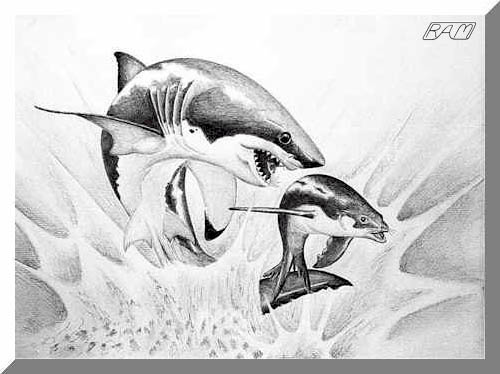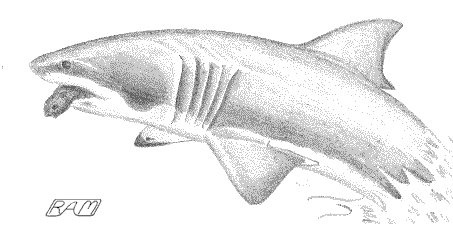White Shark Predatory Behavior
at Seal Island
Predation is one of the most fundamental interactions in Nature and one of the most inherently fascinating. But predation is rarely observed in the wild. Seal Island, in False Bay, South Africa, provides unique opportunities to observe natural predation by White Sharks on Cape Fur Seals and to observe social interactions among both species.

A Partial Predatory Ethogram of the White Sharks at Seal Island
'Polaris Attack' - the attacking shark performs a swift, vertical rush; often leaping partially or completely out of the water, with or without a seal in its mouth; if seal is in the shark's mouth, it typically shakes its head violently from side-to-side, possibly facilitating death or severe injury via neck trauma caused by the 'Lateral Head Shake'; typically devastating, usually killing or incapacitating the seal in the initial strike; those seals which are wounded but not killed in this strike typically bear slashing wounds on the posterior abdomen (probably inflicted by the attacking shark's lower anterior teeth, which form the first point of contact between predator and prey), usually located on the rearmost quarter of the body.
'Surface Broach' - after initial strike, if seal is still alive, the attacking shark performs a swift shallow, horizontal breach, typically re-entering water with jaws over the seal, usually forcing the seal underwater; seals struck in this way are typically wounded on the posterior quarter of the body; if seal is in the shark's mouth, it typically shakes its head violently from side-to-side, possibly facilitating death or severe injury via neck trauma caused by the 'Lateral Head-Shake'; often fatal; sometimes accompanied by 'Side Roll'

'Side Roll' - after initial strike, if seal still alive, the attacking shark performs a moderately fast lateral roll at or near the surface, possibly to keep floating seal in sight or perhaps an artifact of continued pursuit; one of the shark's pectoral fins often protrudes from the water
'Lateral Snap' - when a seal is 'working a shark' (performing zig-zag surface maneuvers in an attempt to stay away from a pursuing shark's jaws), the attacking shark performs a sudden, swift lateral snap of its head, typically grasping the seal with its lateroposterior teeth; seals grasped in this way are typically grasped mid-body, at roughly the level of the foreflippers
'Lateral Head-Shake' - when seal has been grasped during pursuit or killed, the attacking shark performs violent lateral shakes of the head; this action typically breaks the neck of a seal that has not yet succumbed or, if dead, maximizes the cutting efficiency of the shark's serrated dentition by sawing apart the ribcage, which is usually the only potion of a seal carcass that provides any significant resistance to being sundered by the shark's teeth
'Killing Bite' - when a seal has been grasped during pursuit, the attacking shark performs a swift, powerful bite to the seal's head or neck, efficiently killing the prey prior to feeding upon its carcass; often followed by 'Surface Grasp'

'Surface Grab' - after seal is dead or otherwise incapacitated, the attacking shark performs a slow, almost 'casual' grasp of the floating seal; shark typically employs its anterior teeth for doing so, often raising its head partially out of the water; often followed by 'Lateral Head-Shake' or 'Subsurface Carry'
'Subsurface Carry' - after seal is dead or incapacitated and other sharks (competitors) are in the immediate vicinity (a kill often draws as many as four additional White Sharks), the attacking shark may slowly grasp and carry the seal's body underwater some distance - typically 5 to 8 metres or so - possibly to assert its ownership of the prey item or to otherwise discourage competitors from stealing it
'Surface Feed' - after seal is dead, the attacking shark consumes the prey; due to its high blubber content, the seal carcass floats at the surface and it is there that the shark calmly but efficiently feeds upon it; consumption is typically performed in two or three massive bites - often employing 'Lateral Head-Shake' to saw apart the carcass' rib cage - and lasts a duration of less than a minute; the seal's entrails are rarely consumed by a feeding White Shark (although the Kelp Gulls and other seabirds compete vigorously and noisily for same) and the head is sometimes also abandoned (low quality food item?) to sink out of sight, probably to be picked clean by crabs and other benthic scavengers
'Spy Hop' - in which a White Shark raises its head above the surface, apparently to survey what is occurring above the waves; rarely observed. Context(s) and adaptive value uncertain.
Predatory Strategies of White Sharks at Seal Island
From direct observation and the data collected, hunting White Sharks apparently:
-
stalk surface-swimming Cape Fur Seals from near the bottom, probably relying on crypsis afforded by the murky water and the dark, rocky bottom against which their dark dorsal surfaces render the predators all but or wholly invisible (direct observation indicated that White Sharks at Seal Island were very difficult or impossible to detect visually below a depth of about 2.5 metres; all recorded attacks took place in water at least 6 metres deep)
-
target young seals (84% of recorded attacks were on #2 seals), which are presumably less experienced at predator avoidance and smaller than are older seals, probably making them easier to catch, overpower, and consume
-
target lone or small groups (2-6) of seals (all recorded attacks in which it was possible to estimate group size prior to attack were on fewer than 7 seals), which may be more vulnerable due to limited vigilance capabilities of such a small group
-
target groups of seals as they return to the island, possibly because they are tired, well-fed, and less attentive than groups of seals heading seaward to forage
-
initiate attacks on seals offshore, which probably enhances a White Shark's likelihood of success because the prey animals are far from the safety of the shore, seal subsurface vigilance is limited to the sensory capabilities of the small group targeted, and water depth is sufficient to allow an efficient and forceful vertical strike from beneath
-
make the initial strike seals just as or immediately before they surface while traveling, probably because the path of the seals is relatively easy to predict and/or, as they surface, the mammals themselves are momentarily unable to see beneath the waves
-
attack seals at or near the surface via a sudden, vertical rush, which probably maximizes a White Shark's likelihood of successful prey capture because the seals' location is clearly silhouetted against the brightness of Snell's window, the prey has limited options for escape, and the seals' likelihood of detecting an attacking shark is minimized by the directness - and thus briefness - of the shark's attack, the minimization of the shark's profile during attack (limited to its cross-section rather than it's full length), and the difficulty in judging distance to the attacking shark; the resulting factors conspire to make it difficult for seals to properly assess the immediacy of threat posed by an attacking shark and to decide upon an appropriate course of action quickly enough to avert capture
-
bite seals engaged in evasive zig-zag maneuvers on the surface via a sudden lateral snap of the jaws (a movement at which the fast-twitch muscles of the head, such as the dorsal and lateral constrictors and the anterior epaxials, are particularly adept), catching the seal with the lateroposteror teeth near the fulcrum of the jaw, where the bite is most powerful and thus devastating
-
consume the disabled prey promptly (i.e., without the 'classic' bite-spit-and-wait behavior described for White Sharks in California waters; the collected data indicate the average duration of a predatory event, from initial strike to consumption is less than 2 minutes), possibly due to the high level of competition among White Sharks at Seal Island for access to a kill; observations indicate that a seal kill at Seal Island may be attended by at least four individual white sharks
In short: the White Sharks' main predatory strategies rely on stealth and surprise.
Video Clips of Natural Predation by White Sharks on Cape Fur Seals
A classic Surface Pursuit - MPEG 2.6 Mb
A classic Polaris Attack - MPEG, 2.8Mb
Click Here to compare and contrast the White Shark predatory behaviors reported here with those reported by researchers based at the Farallon Islands, California.
| Note: Although the contents of this page is drawn largely from my own observations, I would like to acknowledge that many of these shark behaviors were first pointed out to me by two very talented South African naturalists, Chris Fallows and Rob Lawrence, of African Shark Eco-Charters. Were it not for Chris's and Rob's generosity in sharing their observations, I could not have gotten a conceptual handle on what's going on at Seal Island as quickly as I did. |
